Preparation and Mechanical Properties of Flexible Prepreg Resin with High Strength and Low Creep
Abstract
1. Introduction
2. Experimental Methods
2.1. Materials
2.2. Synthesis of Epoxy-Terminated Urethane Resin (EUR)
2.3. Preparation of Prepreg Resin
2.4. Characterization and Performance Testing
3. Results and Discussion
3.1. FTIR and Molecular Weight Analysis of the Resin
3.2. Process Analysis of Prepreg Resin
3.3. Tensile, Bending, and Impact Resistance Analysis
3.4. Microscopic Analysis of Impact Fracture Surface
3.5. Viscoelastic Analysis
3.6. Analysis of Creep Reduction Mechanism
4. Conclusions
Author Contributions
Funding
Institutional Review Board Statement
Data Availability Statement
Conflicts of Interest
References
- Das, H.N.; Kapuria, S. On the use of bend–twist coupling in full-scale composite marine propellers for improving hydrodynamic performance. J. Fluids Struct. 2016, 61, 132–153. [Google Scholar] [CrossRef]
- Herath, M.T.; Natarajan, S.; Prusty, B.G.; St. John, N. Smoothed finite element and genetic algorithm based optimization for shape adaptive composite marine propellers. Compos. Struct. 2014, 109, 189–197. [Google Scholar] [CrossRef]
- Paik, B.-G.; Kim, G.-D.; Kim, K.-Y.; Seol, H.-S.; Hyun, B.-S.; Lee, S.-G.; Jung, Y.-R. Investigation on the performance characteristics of the flexible propellers. Ocean Eng. 2013, 73, 139–148. [Google Scholar] [CrossRef]
- Zhang, J.; Wu, Q.; Wang, G.; Liu, T. Numerical analysis on propulsive efficiency and pre-deformated optimization of a composite marine propeller. Sci. China Technol. Sci. 2020, 63, 2562–2574. [Google Scholar] [CrossRef]
- Hussain, M.; Abdel-Nasser, Y.; Banawan, A.; Ahmed, Y.M. Effect of hydrodynamic twisting moment on design and selection of flexible composite marine propellers. Ocean Eng. 2021, 220, 108399. [Google Scholar] [CrossRef]
- Lee, H.; Song, M.-C.; Han, S.; Chang, B.-J.; Suh, J.-C. Hydro-elastic aspects of a composite marine propeller in accordance with ply lamination methods. J. Mar. Sci. Technol. 2017, 22, 479–493. [Google Scholar] [CrossRef]
- Ho, Y.-C.; Sasayama, H.; Yanagimoto, J. Mechanical properties and drawing process of multilayer carbon-fiber-reinforced plastic sheets with various prepreg thicknesses. Adv. Mech. Eng. 2017, 9, 1–10. [Google Scholar] [CrossRef]
- Chung, D.D.L. Processing-structure-property relationships of continuous carbon fiber polymer-matrix composites. Mater. Sci. Eng. R Rep. 2017, 113, 1–29. [Google Scholar] [CrossRef]
- Yazdi, A.A. Study nonlinear vibration of cross-ply laminated plates using scale models. Polym. Compos. 2013, 35, 752–758. [Google Scholar] [CrossRef]
- Niazi, M.; Beheshty, M.H. A new latent accelerator and study of its effect on physical, mechanical and shelf-life of carbon fiber epoxy prepreg. Iran. Polym. J. 2019, 28, 337–346. [Google Scholar] [CrossRef]
- Pouladvand, A.R.; Mortezaei, M.; Fattahi, H.; Amraei, I.A. A novel custom-tailored epoxy prepreg formulation based on epoxy-amine dual-curable systems. Compos. Part A Appl. Sci. Manuf. 2020, 132, 105852. [Google Scholar] [CrossRef]
- Yao, J.; Zhan, H.; Zou, Z. Preparation and Curing Behaviour of Epoxy Based Film for Moderate Temperature Prepreg. Polym. Polym. Compos. 2017, 25, 621–626. [Google Scholar] [CrossRef]
- Fazlali, B.; Upadhyay, S.; Ashokbhai Ashodia, S.; Mesquita, F.; Lomov, S.V.; Carvelli, V.; Swolfs, Y. Specimen designs for accurate tensile testing of unidirectional composite laminates. Compos. Part A Appl. Sci. Manuf. 2023, 175, 107799. [Google Scholar] [CrossRef]
- Ueki, Y.; Lilholt, H.; Madsen, B. Experimental evaluation of stiffness predictions of multiaxial flax fibre composites by classical laminate theory. PLoS ONE 2020, 15, e0234701. [Google Scholar] [CrossRef] [PubMed]
- Yan, H.; Xie, W.; Gao, B.; Yang, F.; Meng, S. A multi-task learning model for fast prediction of mechanical behavior of UD-CFRP composites under transverse tension. Compos. Struct. 2023, 324, 117555. [Google Scholar] [CrossRef]
- Krishna, R.P.M.; Kumar, A.M.; Goutham, S.K. Development of In-house Unidirectional Carbon/epoxy Prepregs and its Characterization for Aerospace Applications. Procedia Struct. Integr. 2019, 14, 176–183. [Google Scholar] [CrossRef]
- Zhu, Z.; Lu, K.; Ling, H.; Yu, Y.; Li, G.; Yang, X. Enhanced longitudinal compressive strength of CFRP composites with interlaminar CNT film prepreg from hot-melt pre-impregnation. Compos. Commun. 2023, 37, 101457. [Google Scholar] [CrossRef]
- Hesabi, M.; Salimi, A.; Beheshty, M.H. Development of amine-based latent accelerator for one-pot epoxy system with low curing temperature and high shelf life. Eur. Polym. J. 2019, 112, 736–748. [Google Scholar] [CrossRef]
- Neumeyer, T.; Bauernfeind, A.; Eigner, V.; Mueller, C.; Pramberger, K.; Altstaedt, V. Novel epoxy prepreg resins for aircraft interiors based on combinations of halogen-free flame retardants. CEAS Aeronaut. J. 2018, 9, 235–248. [Google Scholar] [CrossRef]
- Baig, Z.; Akram, N.; Zia, K.M.; Saeed, M.; Khosa, M.K.; Ali, L.; Saleem, S. Influence of amine-terminated additives on thermal and mechanical properties of diglycidyl ether of bisphenol A (DGEBA) cured epoxy. J. Appl. Polym. Sci. 2019, 137, 48404. [Google Scholar] [CrossRef]
- Mi, X.; Liang, N.; Xu, H.; Wu, J.; Jiang, Y.; Nie, B.; Zhang, D. Toughness and its mechanisms in epoxy resins. Prog. Mater. Sci. 2022, 130, 100977. [Google Scholar] [CrossRef]
- Vijayan P., P.; Pugliab, D.; Al-Maadeeda, M.A.S.A.; Kennyb, J.M.; Thomas, S. Elastomer/thermoplastic modified epoxy nanocomposites: The hybrid effect of ‘micro’ and ‘nano’ scale. Mater. Sci. Eng. R 2017, 116, 1–29. [Google Scholar] [CrossRef]
- Chu, F.; Ma, C.; Zhang, T.; Xu, Z.; Mu, X.; Cai, W.; Zhou, X.; Ma, S.; Zhou, Y.; Hu, W.; et al. Renewable vanillin-based flame retardant toughening agent with ultra-low phosphorus loading for the fabrication of high-performance epoxy thermoset. Compos. Part B Eng. 2020, 190, 107925. [Google Scholar] [CrossRef]
- Huo, S.; Ma, H.; Liu, G.; Jin, C.; Chen, J.; Wu, G.; Kong, Z. Synthesis and Properties of Organosilicon-Grafted Cardanol Novolac Epoxy Resin as a Novel Biobased Reactive Diluent and Toughening Agent. ACS Omega 2018, 3, 16403–16408. [Google Scholar] [CrossRef] [PubMed]
- Li, Y.; Peng, S.; Miao, J.-T.; Zheng, L.; Zhong, J.; Wu, L.; Weng, Z. Isotropic stereolithography resin toughened by core-shell particles. Chem. Eng. J. 2020, 394, 124873. [Google Scholar] [CrossRef]
- Karthikeyan, L.; Mathew, D.; Robert, T.M. Poly(ether ether ketone)-bischromenes: Synthesis, characterization, and influence on thermal, mechanical, and thermo mechanical properties of epoxy resin. Polym. Adv. Technol. 2019, 30, 1061–1071. [Google Scholar] [CrossRef]
- Chen, S.; Xu, Z.; Zhang, D. Synthesis and application of epoxy-ended hyperbranched polymers. Chem. Eng. J. 2018, 343, 283–302. [Google Scholar] [CrossRef]
- Zhang, M.; Chen, M.; Ni, Z. Epoxy polymer toughening using dendritic spherulites microstructure formed by the self-assembly of alkyl branched tri-carbamates with a spacer of isocyanurate ring. Polymer 2020, 186, 122009. [Google Scholar] [CrossRef]
- Bakis, G.; Wendel, J.F.; Zeiler, R.; Aksit, A.; Haublein, M.; Demleitner, M.; Benra, J.; Forero, S.; Schutz, W.; Altstadt, V. Mechanical Properties of the Carbon Nanotube Modified Epoxy-Carbon Fiber Unidirectional Prepreg Laminates. Polymers 2021, 13, 770. [Google Scholar] [CrossRef]
- Jayan, J.S.; Saritha, A.; Deeraj, B.D.S.; Joseph, K. Triblock copolymer grafted Graphene oxide as nanofiller for toughening of epoxy resin. Mater. Chem. Phys. 2020, 248, 122930. [Google Scholar] [CrossRef]
- Xia, Y.; Zhang, D.; Li, Z.; Lin, H.; Chen, X.; Oliver, S.; Shi, S.; Lei, L. Toughness modification of cationic UV-cured cycloaliphatic epoxy resin by hydroxyl polymers with different structures. Eur. Polym. J. 2020, 127, 109594. [Google Scholar] [CrossRef]
- GB/T 4612-2008; Plastics-Epoxy Compounds-Determination of Epoxy Equivalent. Standardization Administration of the People’s Republic of China: Beijing, China, 2008.
- GB/T 528-2009; Rubber, Vulcanized or Thermoplastic-Determination of Tensile Stress-Strain Properties. Standardization Administration of the People’s Republic of China: Beijing, China, 2009.
- GB/T 9341-2008; Plastics-Determination of Flexural Properties. Standardization Administration of the People’s Republic of China: Beijing, China, 2008.
- GB/T 1843-2008; Plastics-Determination of Izod Impact Strength. Standardization Administration of the People’s Republic of China: Beijing, China, 2008.
- Bach, Q.-V.; Vu, C.M.; Vu, H.T.; Hoang, T.; Dieu, T.V.; Nguyen, D.D. Epoxidized soybean oil grafted with CTBN as a novel toughener for improving the fracture toughness and mechanical properties of epoxy resin. Polym. J. 2020, 52, 345–357. [Google Scholar] [CrossRef]
- Bassett, A.W.; Honnig, A.E.; La Scala, J.J.; Stanzione, J.F. Network toughening of additively manufactured, high glass transition temperature materials via sequentially cured, interpenetrating polymers. Polym. Int. 2020, 70, 749–758. [Google Scholar] [CrossRef]
- Luo, X.; Li, Y.; Li, S.; Liu, X. Enhancement of Mechanical Properties and Bonding Properties of Flake-Zinc-Powder-Modified Epoxy Resin Composites. Polymers 2022, 14, 5323. [Google Scholar] [CrossRef] [PubMed]
- Georgiopoulos, P.; Kontou, E.; Christopoulos, A. Short-term creep behavior of a biodegradable polymer reinforced with wood-fibers. Compos. Part B Eng. 2015, 80, 134–144. [Google Scholar] [CrossRef]
- Reis, A.K.d.; Monticelli, F.M.; Neves, R.M.; de Paula Santos, L.F.; Botelho, E.C.; Luiz Ornaghi Jr, H. Creep behavior of polyetherimide semipreg and epoxy prepreg composites: Structure vs. property relationship. J. Compos. Mater. 2020, 54, 4121–4131. [Google Scholar] [CrossRef]

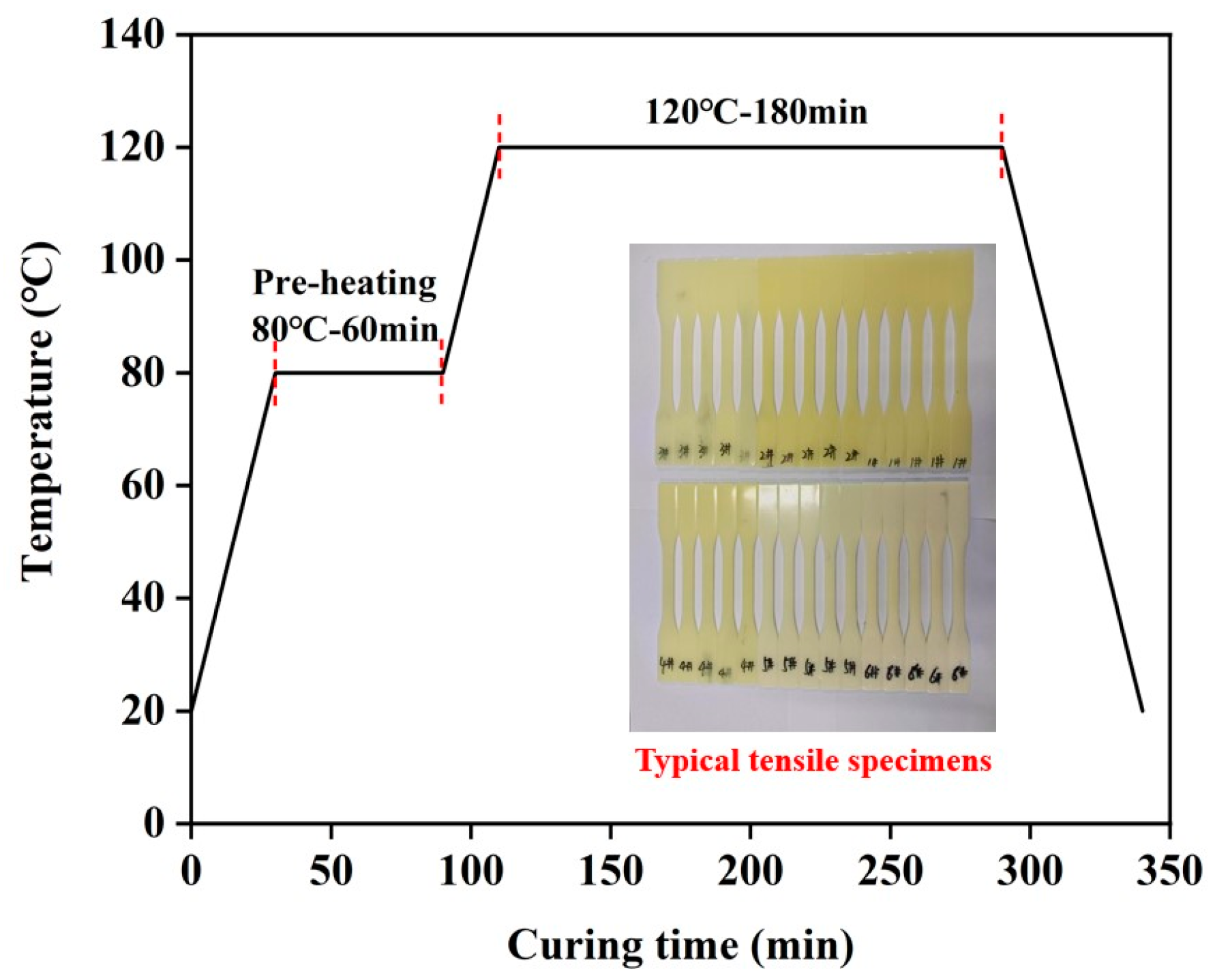

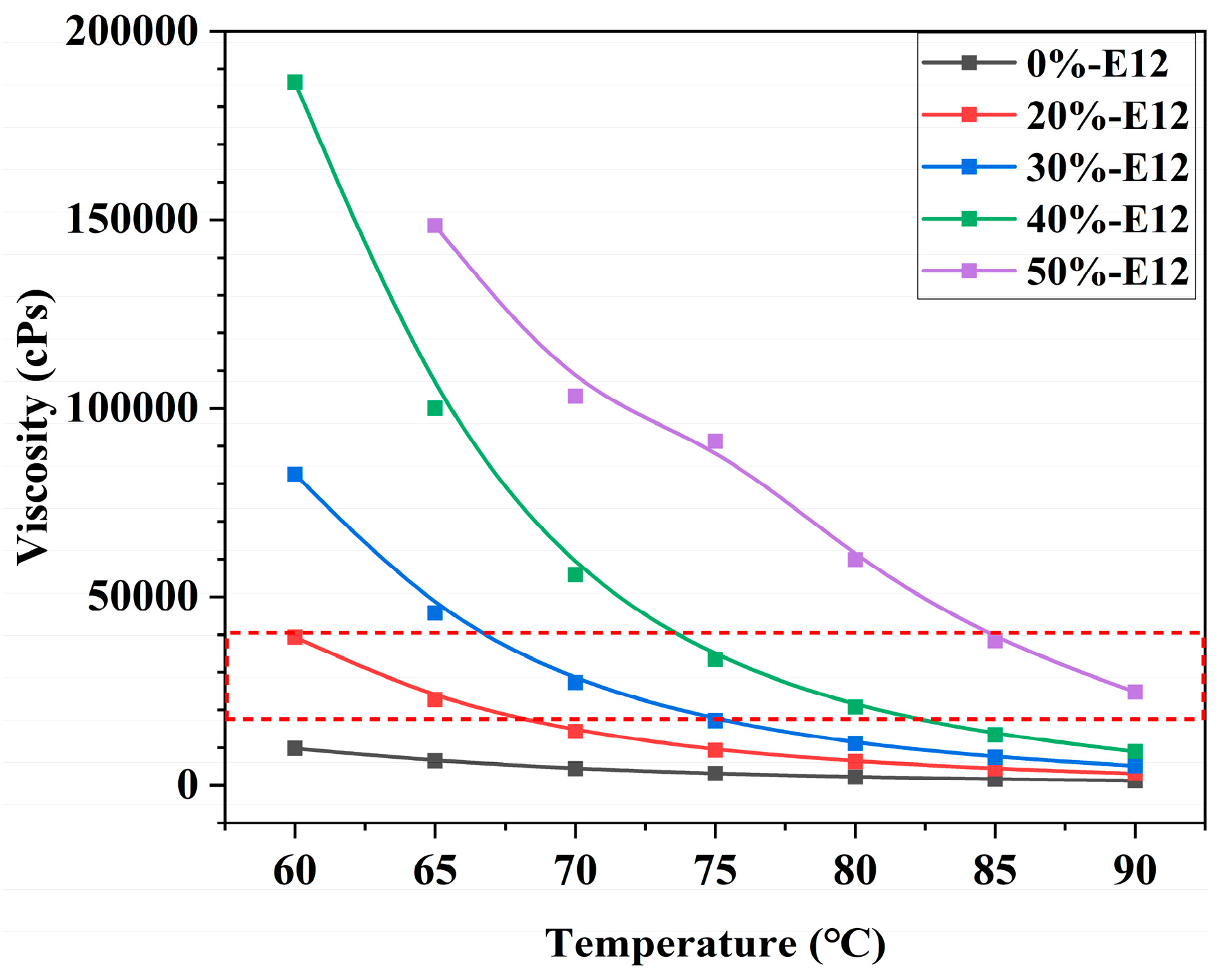
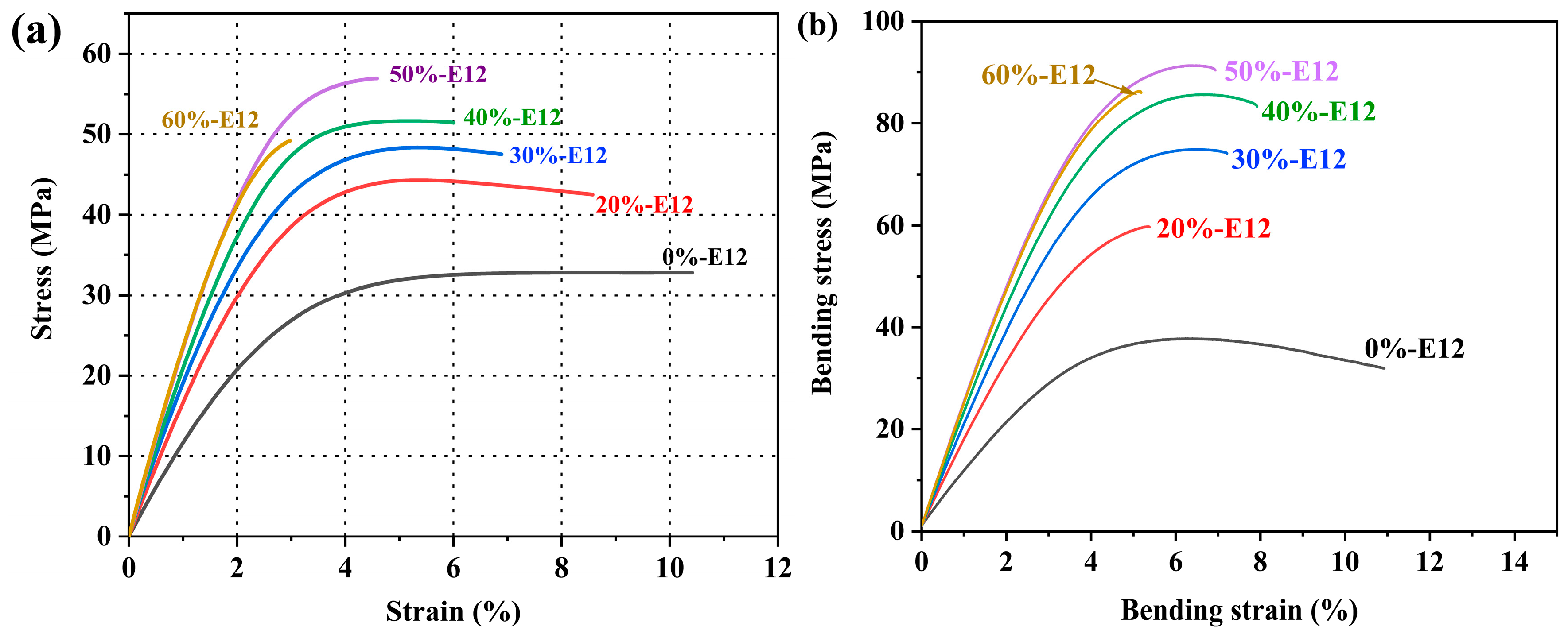
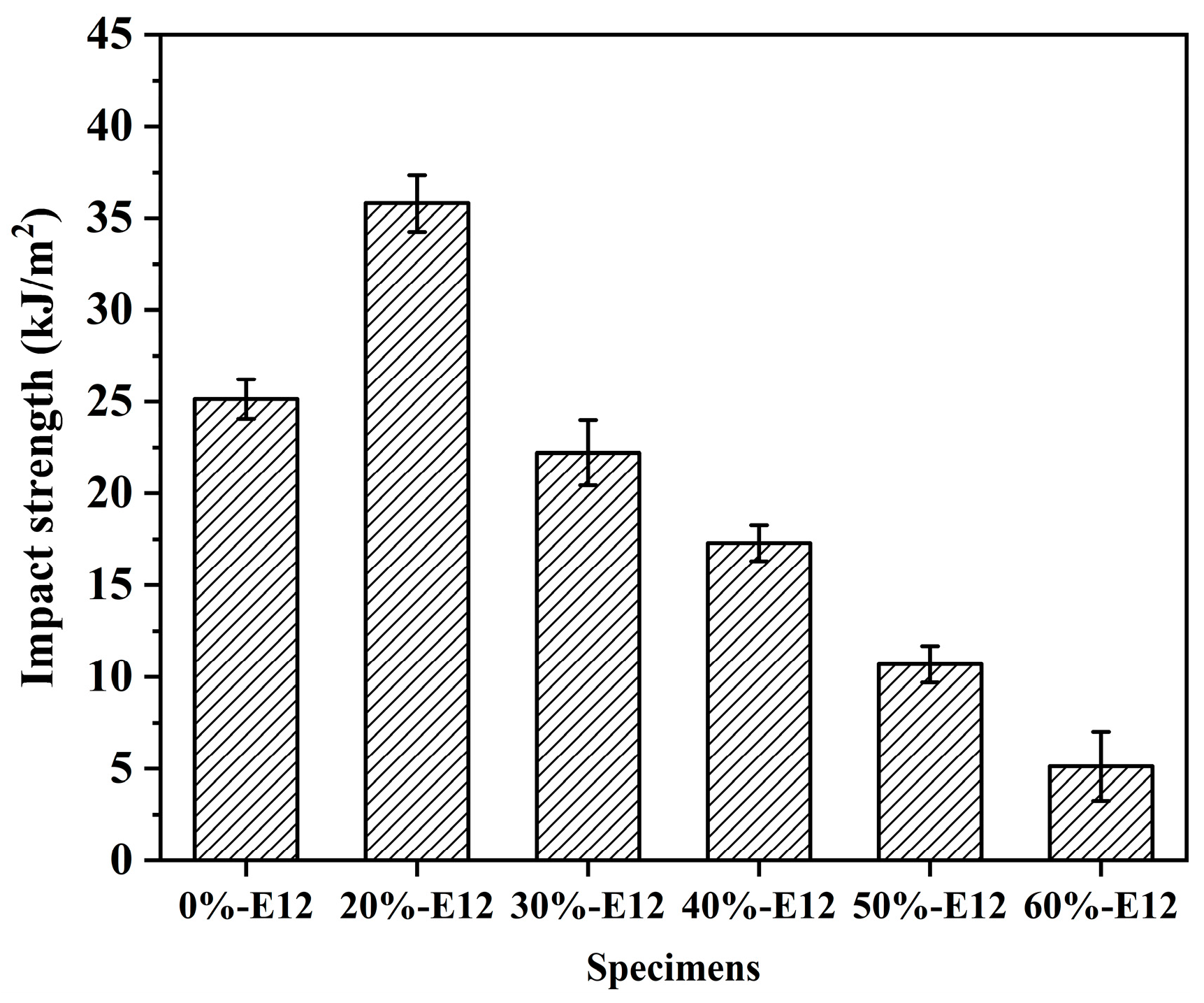
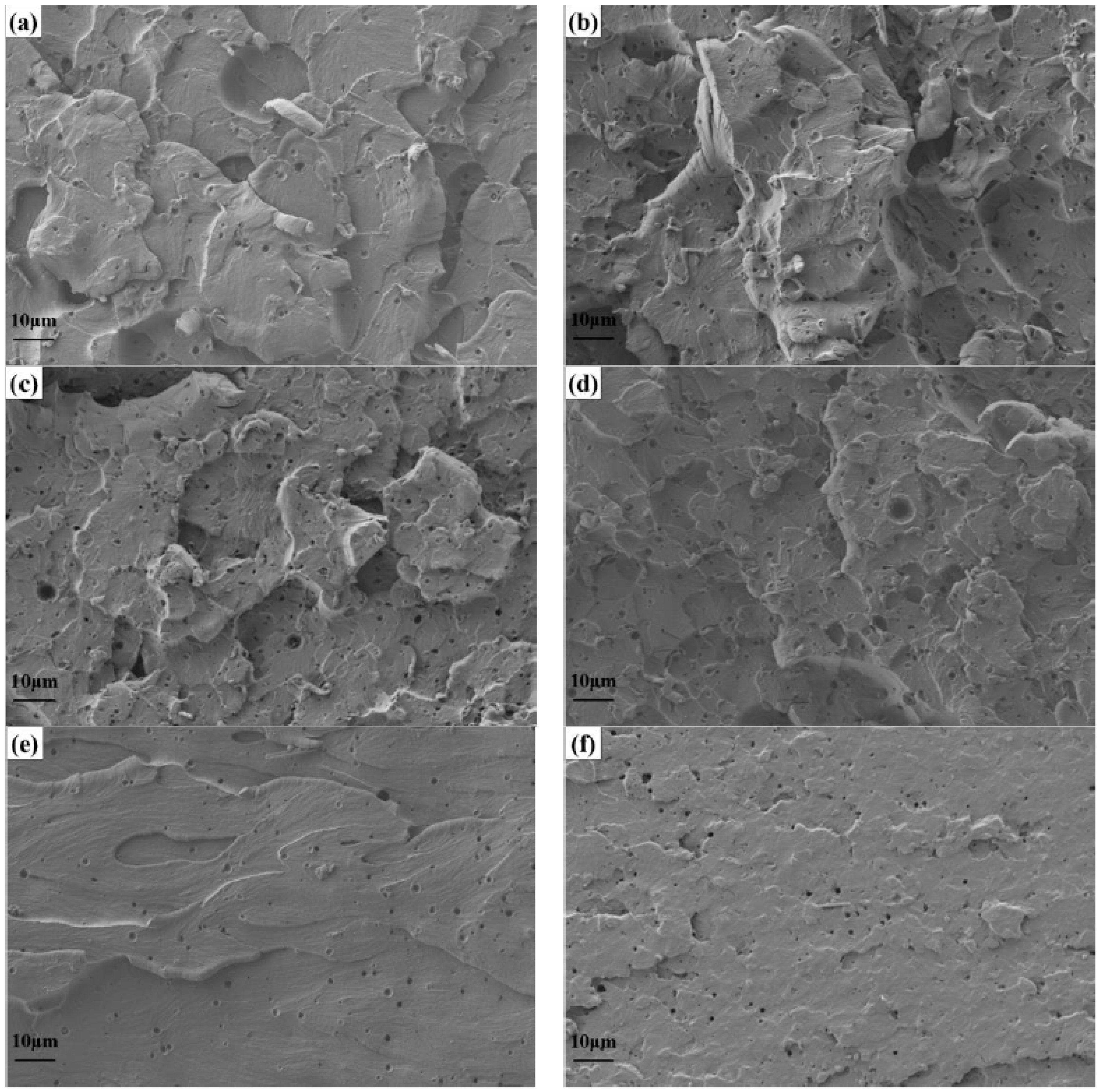

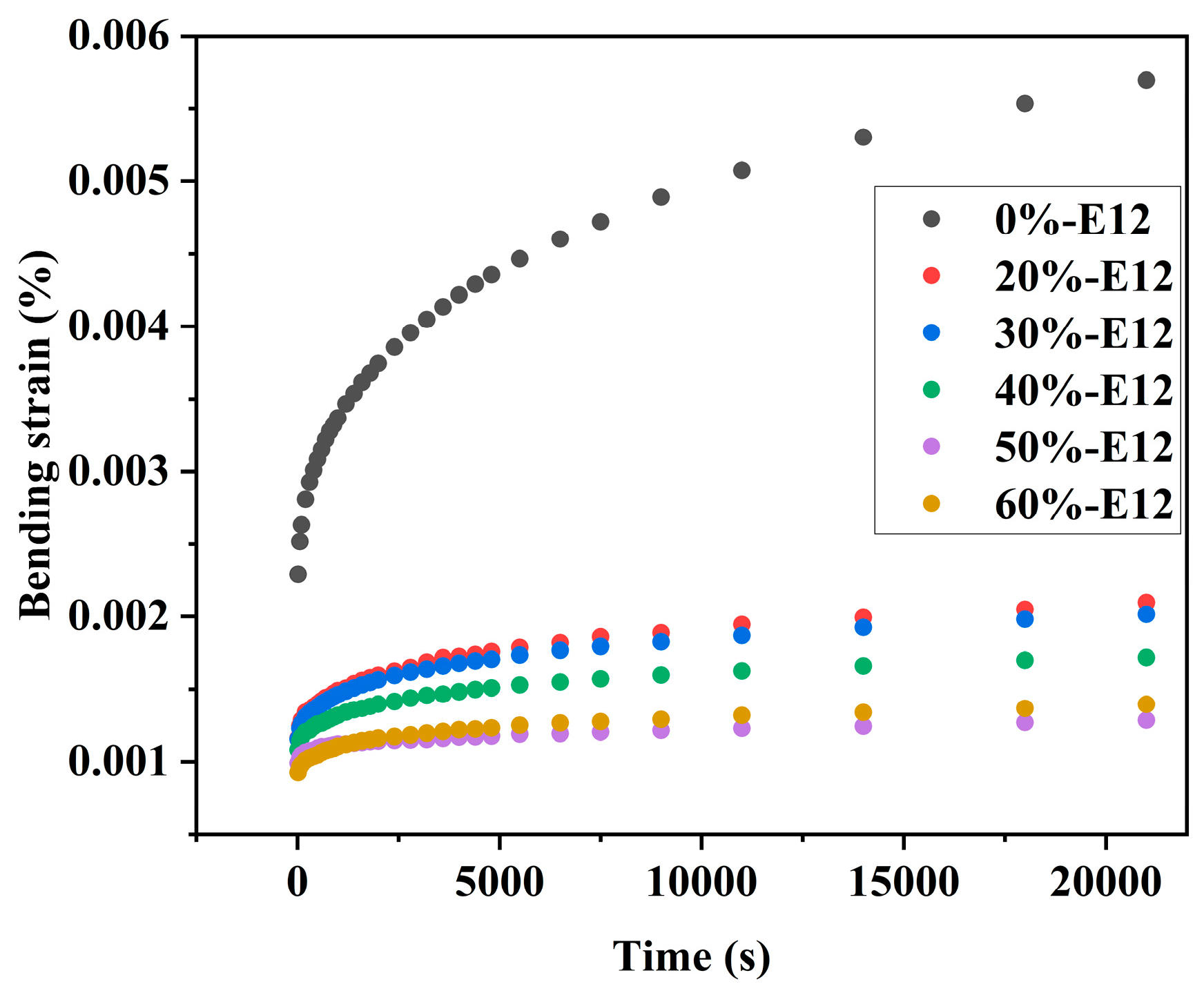
| Specimen | 0%-E12 | 20%-E12 | 30%-E12 | 40%-E12 | 50%-E12 | 60%-E12 |
|---|---|---|---|---|---|---|
| EUR | 100 | 80 | 70 | 60 | 50 | 40 |
| E12 | 0 | 20 | 30 | 40 | 50 | 60 |
| DICY | 4 | 4 | 4 | 4 | 4 | 4 |
| GYHT110 | 1 | 1 | 1 | 1 | 1 | 1 |
| Deform6800 | 0.3 | 0.3 | 0.3 | 0.3 | 0.3 | 0.3 |
| Specimen | Mn | Mw | Mz | Mw/Mn |
|---|---|---|---|---|
| 0%-E12 | 1294 | 1372 | 1479 | 1.06 |
| 20%-E12 | 3256 | 5714 | 8528 | 1.75 |
| 30%-E12 | 4207 | 6224 | 9575 | 1.48 |
| 40%-E12 | 5326 | 7046 | 10,172 | 1.32 |
| 50%-E12 | 6587 | 8407 | 11,952 | 1.28 |
| 60%-E12 | 7199 | 9001 | 12,874 | 1.25 |
| Specimen | 0%-E12 | 20%-E12 | 30%-E12 | 40%-E12 | 50%-E12 | 60%-E12 |
|---|---|---|---|---|---|---|
| Tensile strength/MPa | 32.7 ± 0.4 | 44.7 ± 0.3 | 48.2 ± 0.5 | 52.1 ± 0.4 | 57.6 ± 0.4 | 49.3 ± 1.9 |
| Young’s modulus/MPa | 1227 ± 19 | 1748 ± 14 | 2001 ± 78 | 2181 ± 46 | 2416 ± 66 | 2420 ± 121 |
| Bending strength/MPa | 37.9 ± 0.7 | 59.8 ± 1.1 | 74.9 ± 0.8 | 85.7 ± 0.7 | 91.3 ± 1.2 | 86.3 ± 2.1 |
| Bending modulus/MPa | 1124 ± 35 | 1759 ± 27 | 2073 ± 53 | 2307 ± 22 | 2498 ± 35 | 2445 ± 49 |
| Impact strength/kJ·m−2 | 25.1 ± 1.1 | 35.8 ± 1.6 | 22.2 ± 1.8 | 17.3 ± 1.0 | 10.7 ± 1.0 | 5.1 ± 1.8 |
Disclaimer/Publisher’s Note: The statements, opinions and data contained in all publications are solely those of the individual author(s) and contributor(s) and not of MDPI and/or the editor(s). MDPI and/or the editor(s) disclaim responsibility for any injury to people or property resulting from any ideas, methods, instructions or products referred to in the content. |
© 2024 by the authors. Licensee MDPI, Basel, Switzerland. This article is an open access article distributed under the terms and conditions of the Creative Commons Attribution (CC BY) license (https://creativecommons.org/licenses/by/4.0/).
Share and Cite
Sun, Z.; Mei, Z.; Huang, Z.; Wang, G. Preparation and Mechanical Properties of Flexible Prepreg Resin with High Strength and Low Creep. Polymers 2024, 16, 558. https://doi.org/10.3390/polym16040558
Sun Z, Mei Z, Huang Z, Wang G. Preparation and Mechanical Properties of Flexible Prepreg Resin with High Strength and Low Creep. Polymers. 2024; 16(4):558. https://doi.org/10.3390/polym16040558
Chicago/Turabian StyleSun, Zhaoyi, Zhiyuan Mei, Zheng Huang, and Guorong Wang. 2024. "Preparation and Mechanical Properties of Flexible Prepreg Resin with High Strength and Low Creep" Polymers 16, no. 4: 558. https://doi.org/10.3390/polym16040558
APA StyleSun, Z., Mei, Z., Huang, Z., & Wang, G. (2024). Preparation and Mechanical Properties of Flexible Prepreg Resin with High Strength and Low Creep. Polymers, 16(4), 558. https://doi.org/10.3390/polym16040558





